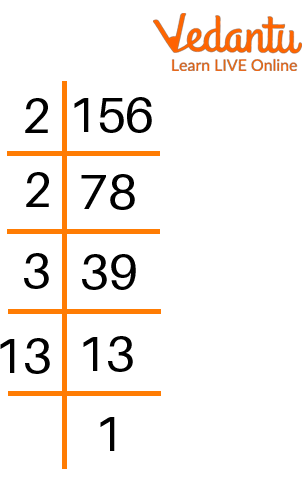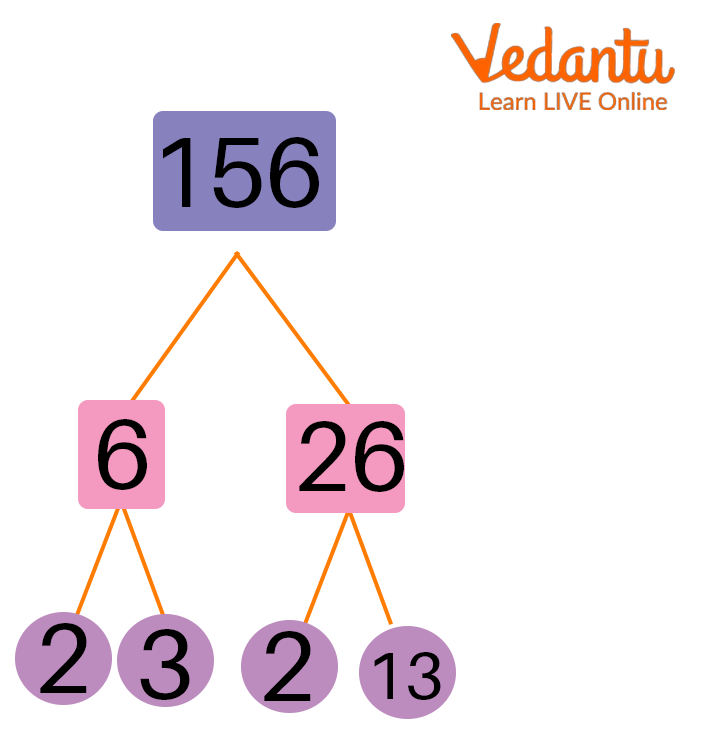




Factor of 156: An Introduction
The factors of $156$ are the numbers that completely divide $156$ and yield zero as a remainder. In addition, these divisors result in a quotient of whole numbers. These divisors, as well as whole number quotients, are referred to as factors. The factors of number $156$ can be expressed in positive form as well as in negative form. Similarly, the pair factors of the number $156$ can be represented using the positive and negative forms.
What are the Factors of $156$?
In Mathematics, the numbers that divide $156$ completely without leaving any remainder are the factors of $156$. In other words, the factors of $156$ are the numbers multiplied in pairs, resulting in the original number $156$. Since the product of two negative numbers is a positive number, $156$ has negative and positive factors, but we will use only positive ones.
Let's start by checking for the factors of $156$. We start with $1$ and check $2, 3, 4, 5, 6, 7$ up to $78$ (half of $78$) to see if any numbers can divide $156$ and leave zero as the remainder, then the corresponding divisor and quotient will be treated as the factors of $156$.
$156 \div 1 = 156$
$156 \div 2 = 78$
$156 \div 3 = 52$
$156 \div 4 = 39$
$156 \div 5 =31.2 (not completely divisible, this is not a factor)
$156 \div 6 = 26$
$156 \div 12 = 13$
$156 \div 13 = 12$
$156 \div 26 = 6$
$156 \div 39 = 4$
$156 \div 52 = 3$
$156 \div 78 = 2$
$156 \div 156 = 1$
Therefore, the Factor of $156$: $1, 2, 3, 4, 6, 12, 13, 26, 39, 52, 78$ and $156$(itself).
Negative Factors of $156$
It is possible to have negative factors of 156 in mathematics. Therefore, if we just reverse the positive numbers into their opposites, those negative numbers would likewise be factors of $156: -1, -2, -3, -4, -6, -12, -13, -26, -39, -52, -78$, and $-156$
Prime Factor of $156$
A prime number is an integer greater than $1$ whose only factors are $1$ and itself. Prime Factors of $156$ are all the prime numbers that, when multiplied together, equal $156$.
$156$ is divisible by the prime number $2$ which results in $78$. The same step can be applied one more time, and the resultant value will be $39$. Continuing, the number $39$ is divisible by the prime number $3$, and the result after division will be $13$. The result $13$ cannot be divided further as it is a prime number.
Hence the prime factors of $156$ are $2, 2, 3, 13$.
Prime Factorization of $156$
The method used to determine which prime numbers can be multiplied to produce the original number is known as prime factorization. The prime factorization of $156$ is $2\times 2\times 3\times 13$.

Prime Factorization of 156
Here, $156$ is an even composite number, which can be further divided into its prime factors. Thus, $156$ is written as the product of $12$ and $13$.
Here, $13$ is a prime number, and $12$ is a composite number that can again be split as $4\times 3$ and equal to $2\times 2\times 3$.
Thus, $156$ is written as $2\times 2\times 3\times 13$.
Therefore, the prime factorization of $156$ is $2\times 2\times 3\times 13$ or $2^2\times 3\times 13$, where $2, 3 and 13$, are prime numbers.
Factor Tree of $156$
The factors of $156$ in tree form are

Factor Tree of 156
Pair Factor of $156$
In maths, a factor pair is defined as a set of two factors, which, when multiplied together, give the number.
A factor pair is a combination of two factors that can be multiplied to equal $156$.
Positive Pair Factors of $156$:
$1 \times 156 = 156$ ; $\left ( 1,156 \right )$
$2 \times 78 = 156$ ; $\left ( 2,78 \right )$
$3 \times 52 = 156$ ; $\left ( 3,52 \right )$
$4 \times 39 = 156$ ; $\left ( 4,39 \right )$
$6 \times 26 = 156$ ; $\left ( 6,26 \right )$
$12 \times 13 = 156$ ; $\left ( 12,13 \right )$
We can also obtain negative pair factors as the product of two -ve numbers:
$-1 \times -156 = 156$ ; $\left ( -1,-156 \right )$
$-2 \times -78 = 156$ ; $\left ( -2,-78 \right )$
$-3 \times -52 = 156$ ; $\left ( -3,-52 \right )$
$-4 \times -39 = 156$ ; $\left ( -4,-39 \right )$
$-6 \times -26 = 156$ ; $\left ( -6,-26 \right )$
$-12 \times -13 = 156$ ; $\left ( -12,-13 \right )$
Solved Examples
Example 1: Example 2: Calculate the mean of all the factors of $156$.
Solution: We are aware that factors of $156 = 1, 2, 3, 4, 6, 12, 13, 26, 39, 52, 78 and 156$.
The mean is equal to the total number of terms plus their sum.
$mean =\dfrac{(1+2+3+ 4+ 6+12+13+26+39+52+78+156)}{12}=\dfrac{392}{12}$
The average of all the $156$ factors is, therefore $32.667$.
Example 2: Is $1$ the greatest common factor (G.C.F) of $156$ and $165$?
Solution: Factors of $156 = 1, 2, 3, 4, 6, 12, 13, 26, 39, 52, 78 and 156$.
Factors of $165 =1, 3, 5, 11, 15, 33, 55 and 165$.
Therefore, the common factor of $156$ and $165 = 1, 3$.
Greatest common factor (G.C.F) of $156$ and $165 = 3$.
No, $1$ is not the greatest common factor (G.C.F) of $156$ and $165$.
Example 3: What is the sum of the prime factors of $156$?
Solution: To find the sum of the prime factors of $156$, we will first look at the factors of $156$.
Factors of $156 = 1, 2, 3, 4, 6, 12, 13, 26, 39, 52, 78 and 156$
Of these numbers, the ones that are only divisible by $1$ and themselves are $2, 3 and 13$. Thus, the prime factors of $156$ are $2, 3 and 13$. The last step is to add these up.
$Sum = 2 + 3 + 13 = 18$
We get that the sum of the prime factors of $156$ is $18$.
Practise Question
1. What is the greatest common factor (G.C.F) of $156$ and $157$?
2. How many factors of $156$ are there?
3. Find the common factor of $156$ and $39$?
Answer
1. $1$
2. $12$
3. $1, 3, 13, 39$
Conclusion
The factors of the number $156$ are $1, 2, 3, 4, 6, 12, 13, 26, 39, 52, 78 and 156$.
The prime factorization of the number $156$ is $2\times 2\times 3\times 13$ or $2^2\times 3\times 13$.
FAQs on Factors of 156
1. Find the first ten multiples of $156$.
When $156$ is multiplied by an integer, the result is a multiple of $156$. Let's multiply from $1$ to $10$ to find the first $10$ times $156$:
$156\times 1=156$
$156\times 2=312$
$156\times 3=468$
$156\times 4=624$
$156\times 5=780$
$156\times 6=936$
$156\times 7=1092$
$156\times 8=1248$
$156\times 9=1404$
$156\times 10=1560$
Therefore, the first ten multiples of $156$ are $156, 312, 468, 624, 780, 936, 1092, 1248, 1404$, and $1560$.
2. Find the greatest common factor of $156$ and $52$.
The first step in determining the GCF of $156$ and $52$ is to list the factors of each number.
The factors of $156$: $1, 2, 3, 4, 6, 12, 13, 26, 39, 52, 78 and 156$ itself.
The factors of $52$: 1,2,4,13,26, and 52 itself.
Therefore, we can conclude that $52$ is the greatest common factor or divisor among all of them because it is the largest number that divides equally into each.
3. Is $156$ a composite number or a prime number?
Actually, the number $156$ is composite. The total factors for the $156$ are $12$: $1, 2, 3, 4, 6, 12, 13, 26, 39, 52, 78 and 156$. Given what we already know, a prime number only has one factor—the number itself—and is referred to as a prime number. Composite numbers, on the other hand, have more than these two factors. Although $156$ is not a perfect square and prime number.











